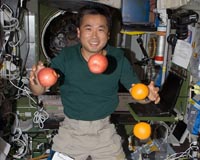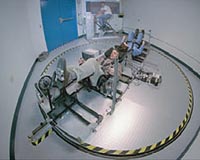 Sushi and fresh underpants await landed astronaut
Sushi and fresh underpants await landed astronaut

Japanese astronaut, Koichi Wakata, who turns 46 on Saturday, said he hoped to celebrate by "having a lot of sushi and birthday cake." |
by Staff Writers
Houston, TX (AFP) Aug 03, 2009
The shuttle Endeavour descended safely to Earth on Friday, spelling a feast of sushi and a clean pair of underpants for one Japanese crew member.
Endeavour's seven member crew, including Japan's Koichi Wakata, touched down at NASA's Kennedy Space Center in Florida at 10:48 am (1448 GMT).
Wakata, adjusting to Earth's gravity after more than four months of weightlessness, told reporters "I still feel a little shaky when I walk, but I'm feeling great."
The Japanese astronaut, who turns 46 on Saturday, said he hoped to celebrate by "having a lot of sushi and birthday cake."
Wakata, Japan's first long-duration astronaut, spent his time mostly carrying out experiments in the International Space Station's Japan's Kibo science laboratory.
The Japanese astronaut, who had flown in space twice previously, returned to Earth aboard Endeavour after 138 days in space and a novel experiment in which he wore a single pair of underwear made from a bacteria resistant fabric for a month.
"My space station crew mates never complained," he told an interviewer on Thursday.
Friday's touchdown ended Endeavour's successful 16-day assembly mission to the ISS, where the shuttle delivered the final piece of Kibo.
There were concerns that early morning thunder storms, coastal rain showers and fog near the Florida landing site might force shuttle commander Mark Polanski and his crew to postpone their return until Saturday.
However, the stormy conditions improved after daybreak, allowing Endeavour to begin its high-speed descent to Earth.
"Welcome home, congratulations on a superb mission from beginning to end," said mission control, as the shuttle rolled to a stop on the Florida runway under sunny skies.
"That's what it's all about," said Polansky, who shared the controls with pilot Doug Hurley for the landing after a "fantastic mission."
"We are happy to be home," Polansky said.
The shuttle astronauts delivered and installed the last major piece of the one-billion-dollar Japanese research complex, the largest and most capable of the station's three primary science modules.
Keiji Tachikawa, president of the Japan Aerospace Exploration Agency, praised Endeavour's crew for finishing the Kibo installation.
"Completing the assembly of all the Kibo elements makes possible various experiments," he said.
"It's extremely important to our country. In addition to gaining valuable knowledge from experiments, Wakata's mission advances our country's future manned space exploration."
The new open platform for external science experiments was fastened to the primary research enclosure and a equipment stowage chamber that were launched last year.
The astronauts also furnished the new platform with an X-ray telescope, an environmental monitor and a communications device to link the space station lab with Japan's mission control in Tsukuba.
Four of the astronauts carried out five long spacewalks in which they equipped the oldest of the station's outstretched solar power modules with new storage batteries and stowed away an assortment of large external spare parts.
Both activities were intended to ensure that the station functions beyond the planned retirement of NASA's space shuttle fleet, now scheduled for late 2010.
The flight also saw a record number of astronauts aboard the 220-mile (354-kilometer) high orbital outpost, representing Europe, Canada, Japan, Russia and the United States.
And with 13 astronauts on the ISS, it was the first time representatives from all of the station's partners have been on the spacecraft at the same time.
"It was truly an impressive demonstration of international cooperation all throughout this mission," said Benoit Marcotte, the Canadian Space Agency's director general of operations.
The large number of astronauts on the station became its own challenge. One of the station's two toilets broken during the mission, as did another device that cleans the breathing air of carbon dioxide.
"Though people think flying on a space station is maybe somewhat routine, it's tremendously challenging," said Polanski.
"You are in a very, very unforgiving environment. Seemingly innocuous things become huge impediments," he said.
"If you have a broken toilet, you don't just run down to Lowe's or Home Depot, or call the plumber. You have to take care of it."
Endeavour dropped off American Tim Kopra at the orbital outpost, where he joined five Russian, Canadian and European astronauts.
Kopra, who is making his first trip to space, is scheduled to return to Earth aboard the shuttle Discovery in early September.
Meanwhile, NASA is preparing the shuttle Discovery for an August 25 mission scheduled to last 11 days.
Discovery's astronauts will deliver research equipment, medical gear and other supplies to the orbital outpost. With the looming retirement of NASA's shuttle fleet, seven missions remain.
Share This Article With Planet Earth
Related Links
Space Tourism, Space Transport and Space Exploration News

 Spinning Now Helps Standing Later
Spinning Now Helps Standing Later
Galveston TX (SPX) Jul 30, 2009
When the Apollo 11 crew got back from the moon, 40 years ago this week, they showed no ill effects from seven days spent in weightlessness. But as American astronauts and Soviet cosmonauts began conducting longer-duration space flights, scientists noticed a disturbing trend: the longer humans stay in zero gravity, the more muscle they lose. Space travelers exposed to weightlessness for a ... read more
|
 |
|

 Spinning Now Helps Standing Later
Spinning Now Helps Standing Later